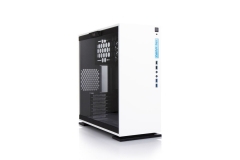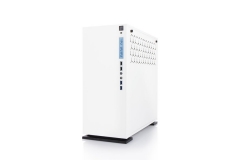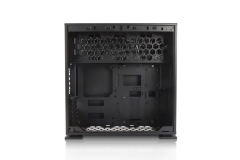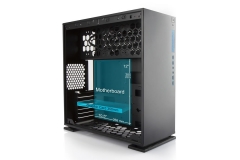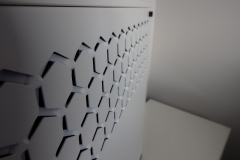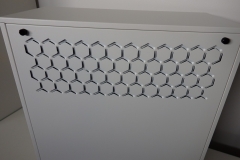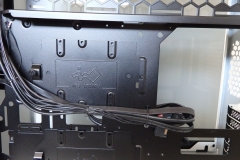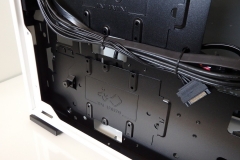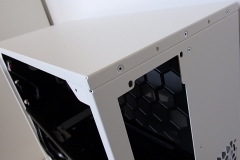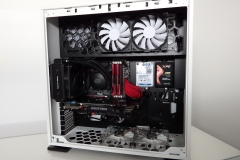The In Win 303 could be one of the best value for money cases on the market right now. With such a stylish look and an entire side-panel made of tinted glass I honestly couldn’t believe the price was such good value.
I grew up in a time when PC Cases were heavy beige steel boxes. Back then motherboards looked nothing like they do here and LEDs were purely functional, not aesthetic. This was a time when side panels, quiet fans and aesthetic design hadn’t been born yet but it wasn’t really THAT long ago either…
Enough about the past, let’s look at the present and presently In Win have some of the most innovative and sexy looking PC cases on the market. The In Win 303 is one of the more affordable In Win cases available to the masses with the white 303 case typically costing $109 although we did spot it even cheaper at one retailer.
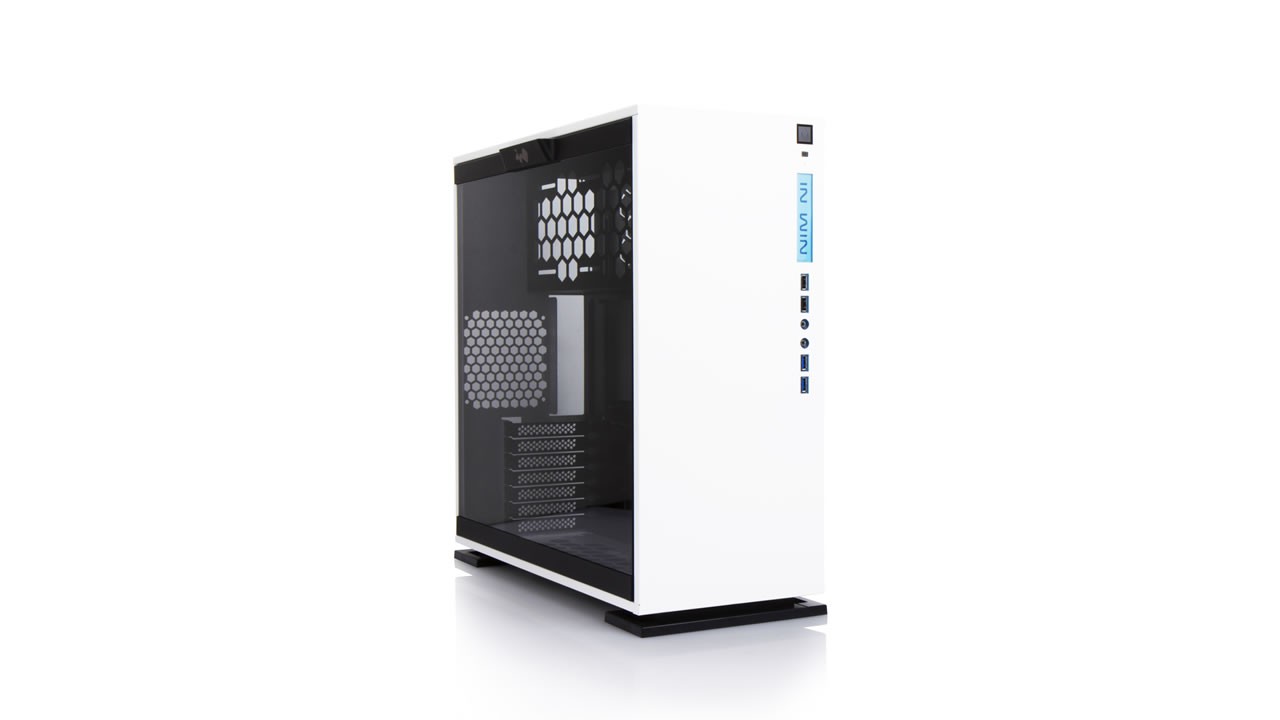
The case is unusual but in a good way. Rather than having a side window, In Win has used a sheet of tempered glass as an entire side panel and attached fittings to the top and bottom edges to make it secure yet easy to remove. The front and top of the case are both devoid of any fan grilles or intake areas – so how does your gaming beast actually breathe? The 303 airflow is less conventional in that it draws fresh air up through the floor of the case, passes it over the motherboard and then expels is either through the rear 120mm fan slot or via the 360x120mm vent on the right case panel.
The design and features of this case are way more interesting than the technical specifications but here they are:
- Model: 303
- Colour: Black, White
- Case Type: Mid Tower
- Case Material: SECC, Tempered Glass
- M/B Compatibility: 12″ x 10.7″ ATX, Micro-ATX, Mini-ITX
- Expansion Slots: PCI-E x 7
- VGA Card Length:350mm
- CPU Heatsink Height :160mm
- Front Ports
- 2 x USB 3.0
- 2 x USB 2.0
- HD Audio
- Internal Drive Bays
- 2 x 3.5″
- 2 x 2.5″
- Pre-installed (Max. up to 3 bays)
- Thermal Solution Compatibility
- 1 x 120mm Rear Fan / 120mm Radiator
- 3 x 120mm Top Fan / 360mm Radiator
- 3 x 120mm Bottom Fan
- Power Supply Compatibility
- PSII: ATX12V
- – Length up to 200mm
- Product Dimension
- (H x W x D) 500mm x 215mm x 480mm
- Product Dimension
- (H x W x D) with screw & handle height 500mm x 248mm x 480mm
- Package Dimension
- (H x W x D) 335mm x 610mm x 572mm
- Net Weight: 10.88kg / 24lb
- Gross Weight: 13.02kg / 28.7lb
The side vent is cleverly designed to have adequate airflow without a large cut-out or typical vent. The hexagon theme of the case internals are carried through to the solid side panel on the right hand side with a really neat optical effect. This is one of the most visually appealing vents that I can remember seeing on a PC case.
Despite not having front or conventional top intake/exhaust ventilation mounts, cooling options are still open to either air or water cooling. CPU heatsinks up to 160mm in height can be used but keep in mind that this is the total height so measure up to the tips of any heat-pipes that may protrude from the top of the fin stack. Radiators are also catered for with the rear 120mm mount, a top 360mm mount and possibly in conjunction with an M-ATX sized motherboard in the floor 360mm mount. There are some things to note here: The top, vertically oriented 360mm mount can hold a full 360mm radiator but the PSU will impair airflow from at least one of the 120mm fans. Triple fans in the top would still look great and the extra surface area would not be entirely wasted. The floor mounted fan mounts should be able to hold up to a 360mm radiator as well with an M-ATX board like the ASUS Maximus VI Gene that we used in our test build, check the motherboard headers, the exact size of the radiator then plan your build carefully to avoid rework and clearance issues. Also keep in mind that In Win don’t market the floor fan mounts as a radiator mount – but we had a look at it and thought some builders could make this work with the right setup.

The floor intake dust cover is easy to remove and looks to be quite effective from our limited testing. We would recommend that you clean this filter more often than a vertical front filter to avoid dust ingress. It isn’t a big deal as the filter frame unclips and slides out in seconds.
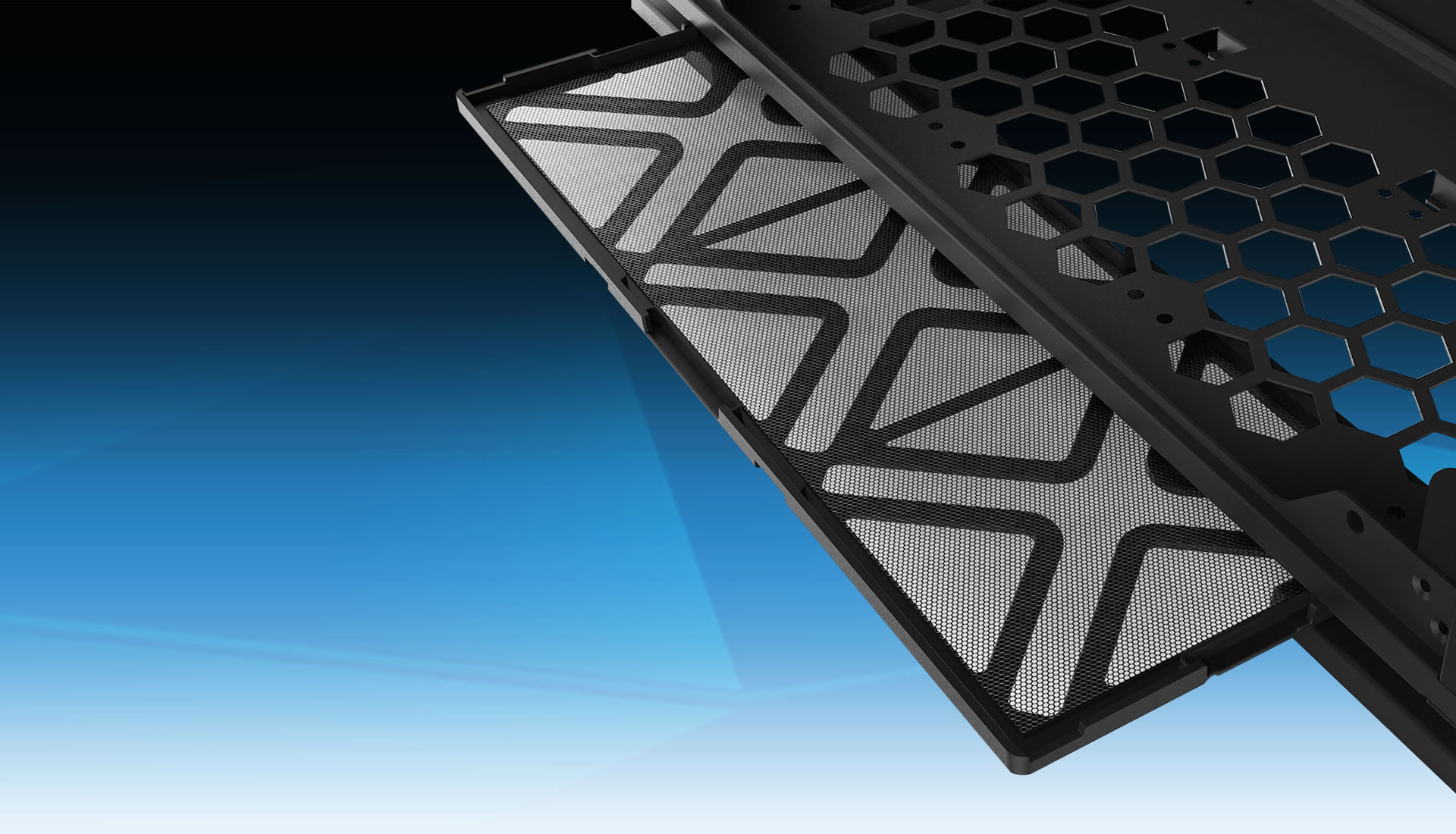
The front panel has USB 2, USB 3, audio, power, reset and HDD activity indicators. The front of the case is simplistic in appearance with a flat panel and the backlit In Win logo. On the black edition of the 303, the backlight is red, on our white review sample, the backlight is blue. As with all colour combinations, this is a subjective area and there will be people that want an option other than those provided. Personally I liked the white/blue combination and noted that the blue LED lighting didn’t bleed into the case so it wasn’t visible through the glass side panel.
The side panel is the hero of the 303. It is tinted 3mm tempered glass and allows you to see the entire contents of your rig. When the PC is turned off, the panel looks much darker, almost black. If you have any LEDs on your motherboard, graphics card or cooling (fans, pump, etc), the 303 really comes to life when it’s switched on. There are 3 mounts (but 2 trays) for 2.5″ SSDs/HDDs next to the motherboard in the main chamber as well as mounts for a reservoir or pump. There two 3.5″ HDD trays and mounts on the underside of the motherboard tray for bulk storage on spinning disk.
Cable management is important here as the glass side panel makes any spaghetti cabling clear to see. Thankfully, In Win has provided enough space behind the motherboard and drive trays to route cables neatly.
In Win also include a graphics card bracket to support longer, heavier graphics cards from sagging or potentially damaging your motherboard.
The 303 is available in black or white and includes a tempered glass side panel as the default configuration but the In Win website does reference a solid side panel as an option. We can’t imagine why anyone would want to swap out the glass side panel for a steel one but at least the option is there.
The packing material is also premium standard and beyond what we would expect from a case in this price range. The 303 comes well packed and inside a cloth bag to protect it from scratches. The instruction manual, accessories and screws are packed in a resealable zip locked clear vinyl bag.
As you can see, the 303 we received matches up with the promo shots and it was in pristine condition when unpacked. The build quality was also of a high standard with a flawless powder coat, no sharp edges and a perfectly clean glass side panel.
Test build
We used the following components in our test build
- ASUS Z87 Maximus VI Gene motherboard
- Intel i5 4670K CPU (overclocked to 4.5GHz @ 1.3v)
- 16 GB ADATA V1 DDR3 (red)
- 480GB ADATA SX930 SSD
- 1TB 2.5″ WD Blue SSHD
- Gigabyte GTX 970 OC Windforce 3 graphics card
- Cooler Master Nepton XL120 120mm AIO water cooler
- Fractal Design Integra 750W Modular Power Supply
- 2x 120mm Fractal Design Silent Series R2 fans (top exhaust)
- 2x 120mm white LED Aerocool Shark fans (bottom intake)
We went with this configuration for a few reasons.
We wanted to overclock our CPU as per a high performance gaming rig to see how the system went thermally. The i5 4670K was perfect for this and we ran with the volts at 1.3v which is slightly higher than we needed but a better test.
The Gigabyte GTX 970 OC Windforce 3 is the longest graphics card that we have and it dumps all of the hot air inside the case. A case with half decent airflow will keep a Windforce card well balanced in terms of heat/noise ratio.
The ASUS Maximus VI Gene motherboard hasn’t featured in a while and we wanted to see how much clearance was at the bottom of the case for a radiator if an M-ATX board was used. Also, I personally really like the Maximus VI Gene – it has been an extremely reliable motherboard with great features and I was looking for an excuse to take it out of one of our LAN rigs and build with it again. The thermal tuning software is also pretty good and meant that we could tune the fans.
ADATA SX930 SSD 480GB and V1 DDR3 memory were aesthetic choices but also solid performers.
We wanted to see if mounting a 2.5″ hard drive on the 2.5″ brackets caused any vibration or noise within the case. Whilst we have other brands of 2.5″ HDD in the cupboard, Western Digital still has a 100% success rate in our builds since 2011 so it was hard to go past the WD blue 1TB SSHD.
The rear 120mm vent looked tight so we chose the Cooler Master Nepton 120XL to see how the end-tank cleared and also how close it sat to the PSU chamber. The clearance is there and we didn’t have any issues fitting the 120mm twin fan cooler to the rear vent.
The fans we used to create airflow were simply what we had in pairs in the office.
The other things we noted when building the test system was how spacious the 303 is. The case is so open inside that the build was faster than expected. The stand-off in the middle of the motherboard tray has an inner raised lip to hold the motherboard in place while you fix it in place. There is also a “Philips-head to hex” socket to make installing the non-permanent stand-offs easier. The case also comes with way more screws and cable ties than we needed which is a good thing.
The bottom fans fit 3 across but the feet on the case can make this a little tricky to get all screws/rubber plugs in. If you fit the fans first before installing the motherboard there shouldn’t be any problems at all.
It would have been nice to see a few more of the rectangular zip-tie anchor points but there were enough places to secure cables so this isn’t a big thing.
The HDD trays are easy to use but you need to use a straight SATA connector as right angle headers won’t reach due to the drive tray/holder.
We also used a 24-pin motherboard power cable extension without any dramas hiding the cables.
The glass side panel does attract finger prints but they wipe off very easily. It also makes photographing the case a little tricky in certain lighting conditions as it becomes a mirror. The flip side is that when in a darkened room, the inner system can look amazing through the tinted glass.
The front panel lighting is powered by a SATA connector which is also a welcome feature as it means we didn’t need to fit a MOLEX cable to our modular power supply.
One really neat thing was the cable cut out in the PSU chamber at the top of the case. There is a well-placed and shaped cut-out to allow for the 8-pin CPU power cable to be passed through to the motherboard so that you can easily stash the excess cable in the PSU chamber out of sight.
The right side panel can be removed with a pair of thumbscrews at the top of the case and it opens vertically, not horizontally. The hexagon shaped vents are really effective visually and we didn’t see any issue thermally either. The benefit of a vertical vent like that is that when idle, dust won’t settle on it as you may experience on a horizontal top vent.
Thermally, the 303 performed well. The CPU and graphics card temperatures were what we would consider normal. The glass side panel didn’t get hot at any point which indicates that the airflow was adequate in terms of transferring the heat away from the components and exhausting from the case.
When gaming on this system, the idle noise was almost inaudible. Under load, the system was audible but not any more offensive than other similarly-priced cases we have tested.
Conclusion
The In Win 303 is a pleasure to build in, has more than adequate airflow, easy access to the front panel I/O ports and a clean aesthetic. The flat roof means that you can place light items such as magazines, manuals, etc on the top without compromising airflow.
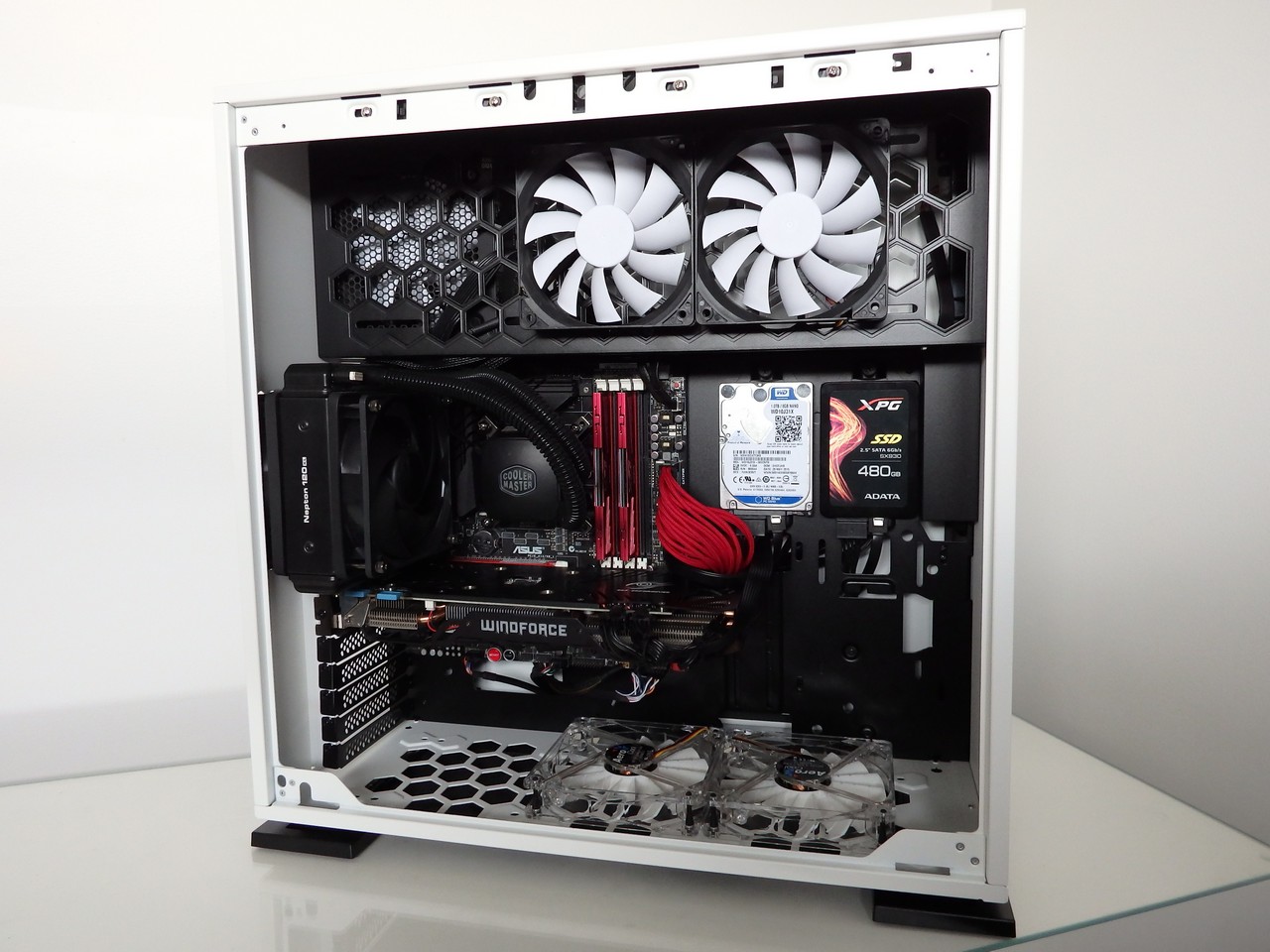
The price is a bargain when you consider the tempered glass side panel and the finish of the 303. Keep in mind that the case does not ship with any case fans nor does it have any grommets. The lack of fans isn’t a deal breaker as enthusiast builders would likely be customising the fans anyway for a particular brand or colour. Personally, I tend to strip the stock fans out of a case and replace them with something better anyway so I’d rather not have to pay for the stock fans.
This is probably one of, if not the best value case doing around right now at $110. The price allows system builders to create a high end system without cheapening the end result with a budget looking case. The tempered glass side panel allows the whole build to be on display.
We absolutely loved this case in the lab and would certainly consider buying it for a personal build.
| In Win 303 Case | |
 |
|
|
PROS |
|
|
CONS |
– No case fans included but this is also a fair enough trade-off to keep the cost down. |
| Awards |   |



